Meet the golf course manager: Neil McLoughlin
Related Articles
In Scotland golf courses didn’t have to close this winter, but that wasn’t the case at Deeside where snow, ice and flooding meant the course was shut for nearly three months, as course manager Neil McLoughlin details.
Nestling on the banks of the River Dee, Deeside Golf Club is a traditional Scottish parkland golf course considered to be one of the best inland courses in Scotland, comprising the 18 hole Haughton Course and nine hole Blairs Course.
We speak to its course manager, Neil McLoughlin, about maintaining the venue – particularly during Covid-19 and extreme weather events.
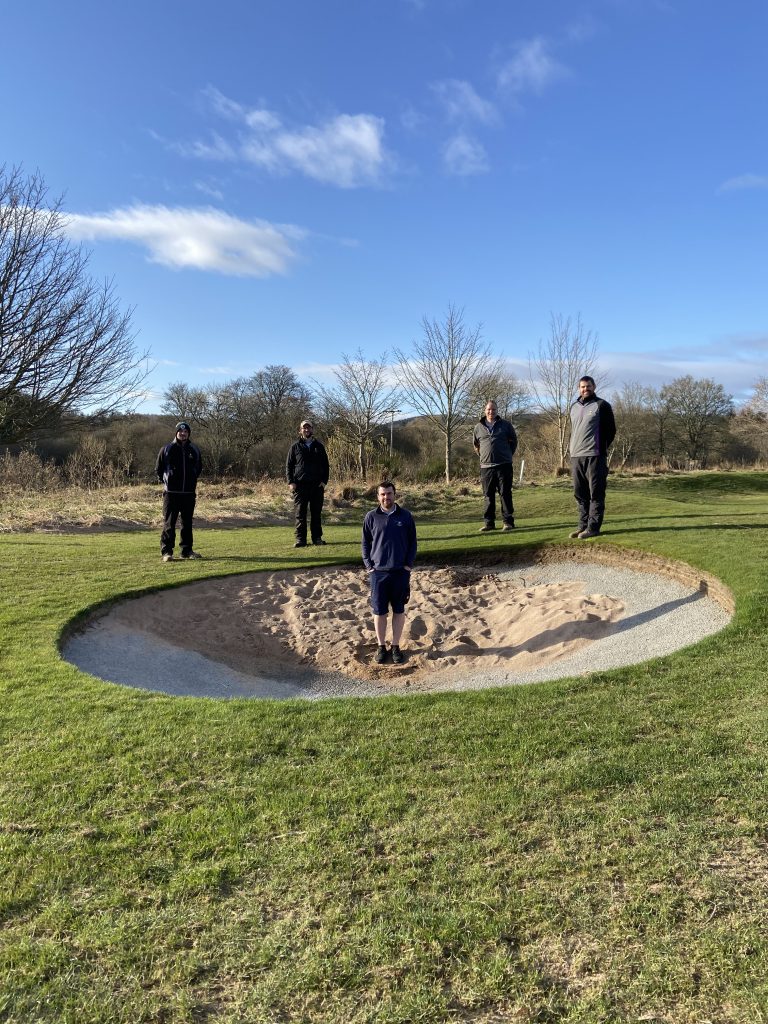
How did you become a greenkeeper and how long have you been at Deeside GC?
I started playing golf when I was about 14 and quickly decided that I wanted to work in the golf industry. While at school and college I had a few summer jobs working at my local club to get some experience. Once I finished my A levels I decided to do a HND in Golf Course Management at Cannington College in Somerset. After finishing at Cannington, I went to America on the Ohio State intern programme, spending nine months at Atlanta Athletic Club and nine months at Southward Ho GC on Long Island. On returning to the UK, I secured a job working for Kenny MacKay at Marriott Forest of Arden. After three years of working at Forest, I moved to Marriott St Pierre as deputy course manager working under Stewart Wood. After spending nearly three years working with Stewart at St Pierre, I moved into my first course manager’s role at The Chase Golf Club near Cannock which was part of the Crown Golf group. It was a very easy transition between the two companies, as they used a lot of the same suppliers and have very similar group deals set up. After a couple of years working for Crown Golf I saw the job at Deeside advertised and was lucky enough to be interviewed and offered the job. I have now been at Deeside for 14 years.
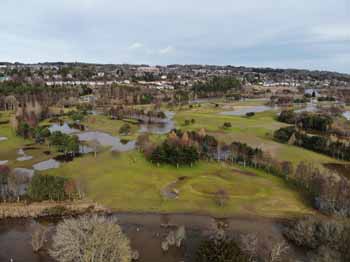
What is the size of your team and how do you spread the workload across the two courses?
At present I have a team of nine full time green keepers and one gardener. There is myself as course manager, Dave Middleton, head greenkeeper of Haughton, Adam Lindsay, Head Greenkeeper of Blairs, Marc Lawrence, Simon Hoy, Andy Baillie, Dave Merchant and Adam Black as fully qualified green keepers and Cameron Riddell, our gardener. We have a team of six looking after the Haughton course and a team of two looking after the nine-hole Blairs course and driving range. Cameron the gardener looks after all areas around the clubhouse driveway and entrance. We generally work as two separate teams, however when there is extra work on, staff on holiday or course maintenance happening, we all just pull together and get the work completed.
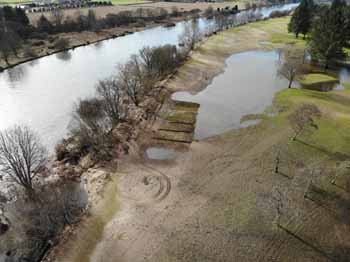
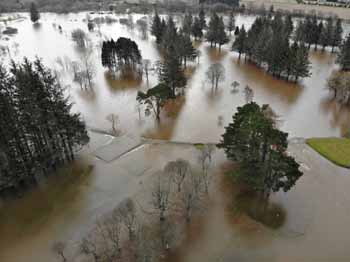
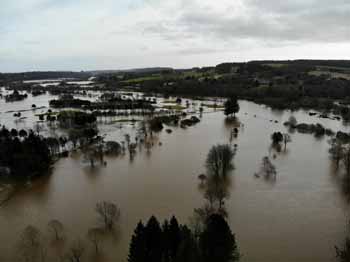
We’ve just had the first ‘real winter’ the course had experienced in ten years. What have been the biggest challenges you faced in maintaining the course over this period – particularly during the pandemic?
Aside from Storm Frank in 2015, this is the first time the courses have had to close for any length of time due to snow and ice. Both courses closed on the 27th December and didn’t re-open until Saturday 13th March. Throughout January/February the closure was due to snow and ice, then on Friday 19th February, after a spike in temperature the snow melt from the mountains flooded the courses. This was followed fours days later with an even bigger flood which brought in more silt, sand and debris.
In terms of the pandemic, like all courses we have had to adapt to new practices. During the summer last year we operated with staggered start and finishing times, to minimize contact. New cleaning protocols were introduced on all equipment, tools and staff areas.
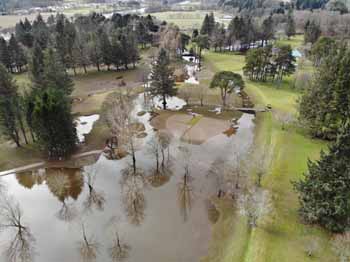
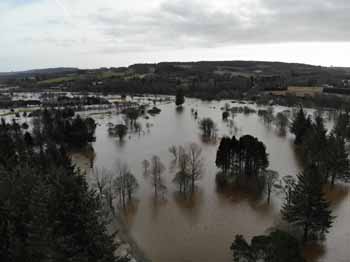
The River Dee seems to have a growing propensity to flood the whole site the two courses are built on. What exactly happens and how do you manage it?
Historically Deeside has always flooded, but until recently the water would come in and go out quite quickly causing little damage and leaving only debris around the site. Since Storm Frank in December 2015, every large flood has brought a mixture of sand, silt sludge and debris. Each area of the courses are affected differently. Some areas where the water is fast flowing the bunker sand is completely washed out, pathways are destroyed and large holes appear at the side of the river bank. Other areas where the river current is slower have large deposits of silt and sand left when the water recedes. The regularity of the floods is increasing, for example this winter there has been three large floods. The fine turf areas are affected the most, with the greens having anything from 2mm to 100mm of silt lying on the surface. To get the courses back open as soon as possible various methods of clearing up are implemented by the team including scraping the surface with snow shovels and washing with a high pressure hose from the irrigation system. Larger areas like fairways are either scraped using a digger or cleaned up using a power brush. The main thing is to uncover the grass plant to allow it to recover. After the clear up the team then work on the aeration program to help improve the drainage and get holes into what silt layer is left.
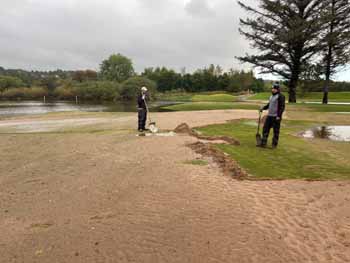
Bunkers obviously become flooded and Capillary Concrete was your bunker liner of choice. What problems / damage were the existing bunkers encountering when the course flooded, what was it about the product that appealed to you and what criteria did you use to make your selection and final decision?
Whenever we flood the bunkers are hit the hardest, with either a layer of silt on top of the sand or the sand washed out of the bunkers and the base of the bunker being eroded, so we have to rebuild the base before we can do anything else. When we start looking at products to line the bunkers, we want something that will stand up to the full force of the flood water. This will help reduce the workload with only re-sanding and tidying up rather than having to rebuild the base from scratch. The main thing that appealed to me about Capillary Concrete was being shown other courses who had suffered major flooding after hurricanes and typhoons. I thought if they can survive that they will survive the river Dee in full spate.
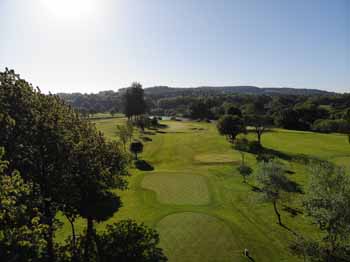
You chose to undertake the installation of the Capillary Concrete bunkers in house with your team, what installation support were you given, how long did it take to complete each bunker, how easy was it to work with the materials and achieve the desired results you were looking for and are you pleased with the outcome?
The club decided to install Capillary Concrete bunkers in-house as we have a very skilled team. Having see the installation of the product at G West in Fife, we knew we could handle it at Deeside. Working with your own team makes the easier with more flexibility in terms of install dates etc. The product was very easy to work with and once you had prepared the base the installation was very quick and easy. We installed six metres cubed of concrete in just two hours. Neil Thompson from Border Sports was on site to help with the installation of the four trial bunkers.
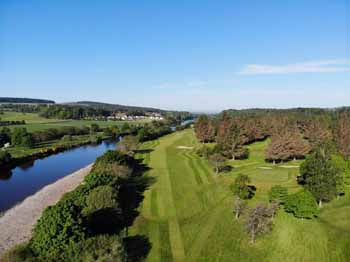
What has the Capillary Concrete delivered to the course bunkers and how well has it stood up to the rather adverse flood conditions?
Capillary Concrete has stood up to the flooding very well. One of the trail bunkers right by the river which normally would be destroyed by a large flood only had about half the sand washed out and the base was perfect. Normally we would have to re-build the base from scratch before filling the bunker with sand again. using this product has allowed us to get the bunkers back in play much sooner.
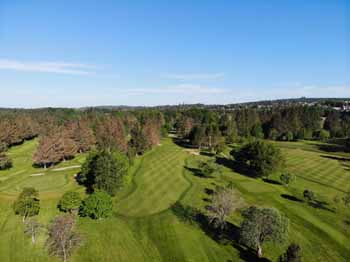
The course has three different types of construction for greens over the courses, what are their characteristics and what challenges do they present to you and the team in terms of maintenance?
At Deeside there are three different constructions of greens. Some of the original greens date back to 1903, some were built in the mid 90’s and then some in 2010. The characteristics vary from green to green. The old sandy loam greens grow the quickest, dry out the quickest and need the least amount of nutrient input. The greens built in the mid 90’s were built to the old USGA spec and cause us the most problems. Although they stay firm, they tend to hold more moisture that the other greens. We believe this is down to the years of flooding and the fine silt mixing into the rootzone filling the pore spaces and slowing down the percolation rate. This is why we concentrate so heavily on aeration and top dressing, to keep the surfaces open and increase the partial size of the rootzone by adding medion course sand. The two greens built in 2010 were built with sand based rootzone and the two newer greens, as you would expect stay drier and require more fertiliser due to their construction.
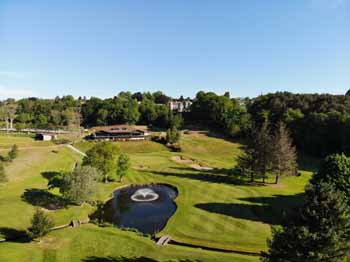
What irrigation system and technology are you currently using?
Both courses have a Rainbird IC irrigation system covering greens, tees, fairways, approaches and surrounds on the Haughton Course and Greens and tees on the Blairs Course. The system was installed just over 11 years ago. To help us judge the amount of water we apply we use a Pogo to measure the moisture content on the greens. The water is drawn from a bore hole into a 200m3 store tank and pumped onto the courses. We control the amount of water we apply using a ‘little and often’ approach rather than soaking the soil. Having a fairly new irrigation system allows us to do this.
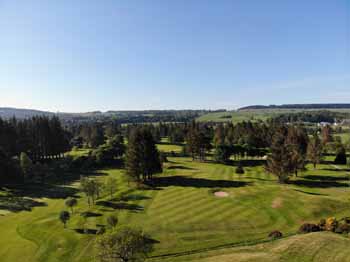
What aeration and top-dressing programmes do you run across the courses?
The team aerate as much as possible due to the build up of silt across the site after a flood. During the season we will pencil tine the greens once a month with 6mm tines to open the surface and we also use a Air2g2 machine every six to eight weeks to help open up the rootzone deeper down. Twice a year we will hollow core the greens to allow us to get more sand into the surfaces and dilute the silt build up. If possible and if weather allows, we will hollow core tees and approaches on both courses once a year. Fairways, surrounds and walkways will all be verti-drained throughout the autumn and spring. On topdressing we aim for around 120 – 150 tonnes of sand per year to be applied to the green. Generally this is a heavy application in the Spring and Autumn, with light applications throughout the season. We also topdress tees and approaches in the Spring after maintenance has been completed. We try to work through a process of topdressing the wettest areas each year to try and firm them up and dilute the silt. The course is definitely more playable during the wet spells because of the additional work the team undertake. The only real downside is that whenever we feel like we are getting somewhere we have another flood and its back to square one. That’s mother nature for you!
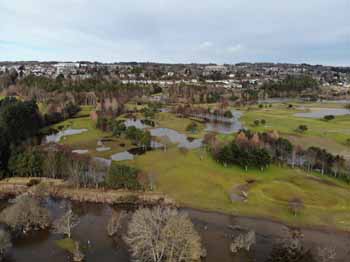
How do you manage the woodland?
Like most tree lined golf courses Deeside suffers from shade issues. Whether that’s in the summer and the grass plant is not getting enough sunlight or winter when the plant doesn’t get enough sunlight and frost lies for most of the day. We spend a lot of time during the winter focusing on tree management. Work includes, crown lifting to allow more sunlight and air movement, thinning out the plantations on the newer side of the Haughton Course, removing dead or high risk trees that could cause problems in the future and planting new trees to replace those which had died and been removed. Like the Capillary bunkers we carry out much of this work in-house, however we rely on external contractors for some higher work. We use a local arboricultural consultant to help with woodland management.
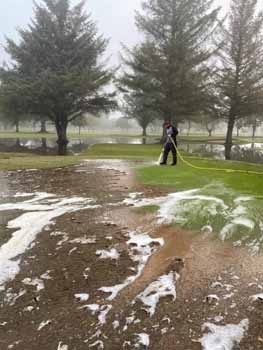
What current machinery fleet are you using and how have you been led by technology, are there a particular piece that you have a preference for or that have impressed you and why?
The machinery at Deeside is mainly split between Toro and John Deere. All our cutting machines are Toro and our transport vehicles are mainly John Deere. We signed a new Toro deal last September replacing old machine with machine with updated technology. We have purchased two new Toro Greenmaster 3370 which are purely battery powered. The quality and performance of these machines are really impressive. Being able to cut greens with very little noise and also reducing the noise impact for our neighbours when the machines leave the shed in the early hours of the morning has been a great bonus. Another positive aspect of these new machines is the confidence in knowing that the machines will not leak any oil! We also purchased a Toro multi pro 5800 with GPS control system. The advantage of this is it reduces any wastage of chemicals and fertilisers, allowing us to focus on spraying targeted areas and set up buffer zones around the ponds and ditches.
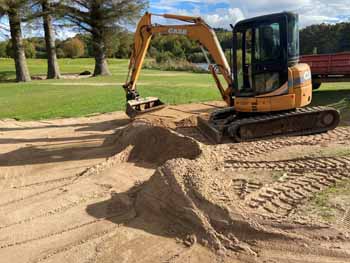
What height of cut do you use across the course?
During the season the greens are cut between 3.75 and 4mm, tees and approaches are cut at 10mm, fairways 12mm, semi rough and surrounds 32mm and rough 62mm. On greens we switch between cutting with a ride on mower and hand mowers throughout the season which can use anything between 26 and 40 man hours per week. Fairways we generally cut twice a week depending on growth rates using roughly 22 hours a week. Cutting tees uses 10 man hours per week, cutting approaches about 10 man hours a week as well. Cutting semi rough and rough can be a continuous task all depending on growth rates, but normally you would be looking at about 48 man hours per week on rough and 32 man hours per week on semi rough and surrounds.
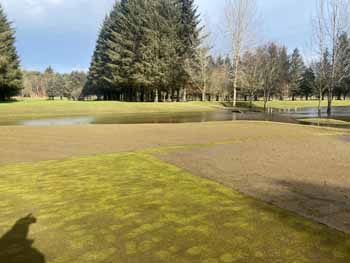
What do you think are the strengths that have carried you through your career and current position at Deeside Golf Club and what plans do you have in place to keep the course evolving?
I have a very strong work ethic and fairly laid back so when things do go wrong I don’t dwell on it, I look at ways to put it right. I’m not afraid of trying new processes and I think this helps my development and that of my team. Deeside have just appointed a golf course architect Edward Design International, they will do a full review of the whole facility and look at ways in which we can develop as a Club. Filling more bunkers with Capillary Concrete will be part of the bunker master plan.
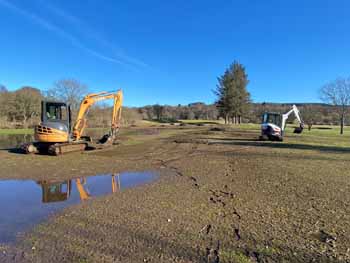
Training and education are key to developing a good team, what are your views on this and what does the club do to ensure it is investing in raising the standard of practice and performance of your greenkeeping team members?
Continuous professional training is vitally important for all employees, whether it’s practical (spraying, chainsaw etc) or more classroom based like HNC , greenkeepers are always learning new techniques from the industry. The Club are very supportive when it comes to training and are willing to invest in the team. We current have one team member completing his HNC in golf course management and another member who has completed is SVQ Level 2 in Land based Engineering. The team also attend regular training days organised by BIGGA. Another training outlet we regularly use is sending a team member to help out at big events like the Scottish Open. They have worked at Courses including Gullane, Castle Stuart, The Renaissance and Royal Aberdeen.
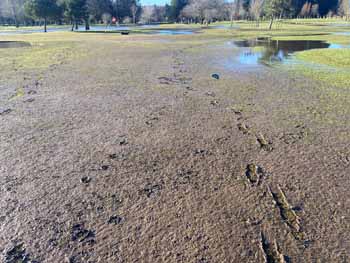
In what ways do you communicate with the members and what information do you convey?
We communicate with the members as often as possible in various different formats. We send out weekly emails, with course updates on work that has been carried out during the week and and work planned for the following week. We give daily updates on course status using ClubV1 and of course we use all the social media platforms. I’m a social media dinosaur so leave that to the team! We also hold a Club member information evening once a year where we talk about winter projects and invite questions from the members. One huge positive that came out of the flooding is the relationship between the members and the greens team. In the aftermath of Storm Frank we had over 250 members help out with the clear up. This gave them an appreciation of the hard work involved in greenkeeping and also built up a great rapport with the team.
The more communication you have with the members the more respect and understanding they have for the job.
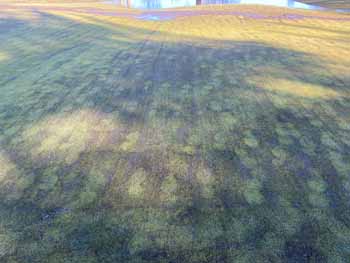
The pressures on the course manager to deliver a better product are growing year on year and the level of professionalism is rising with this. What do you think are the qualities now needed to meet the requirements and demands of golfers by someone in your position and how does this help contribute to the business of golf?
The Course Manager’s position carries a huge amount of weight . There is the pressure to produce an excellent playing surface 365 days a year, regardless of weather, budget and resources. I believe that “out the box” thinking plays a huge part in the success of leading an enthusiastic team. My whole team are involved in coming up with new ideas on how to improve the courses.
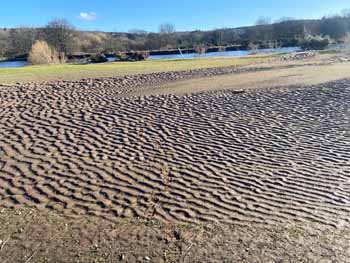
What currently gives you the greatest satisfaction from your job?
I love coming to work and walking round the course every morning and respecting the work the team have put in to producing such great courses. That makes me very proud. Our biggest achievement to date was getting the courses back in action after Storm Frank in 2015. When you see a golf course recovering from that amount of devastation, that would give any course manager huge satisfaction. It truly was an amazing achievement.
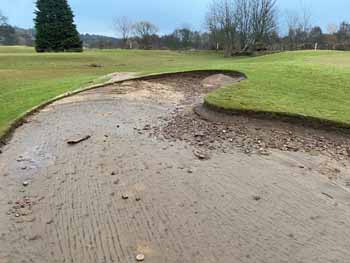
What advice would you give to youngsters starting out and wanting to pursue a career in the profession?
Be willing to work hard, listen and learn. No matter how long someone has been in this industry or what standard / size of course they work on everyone can learn something from everyone else. The more you put into this profession the more you get out of it.
What changes do you think need to be made to benefit the industry and profession of the greenkeeper?
I feel that we need to pull together more as an industry, help each other, talk to each other more. As greenkeepers we all have our own ways of doing jobs. If we can share these ideas and talk to each other it could help greenkeepers out there struggling or it could give you a new way of doing a job that makes life easier. We all have problems at our own site and most of us don’t know what someone just down the road is going through, just by talking to them it could help to relieve their stress.

























